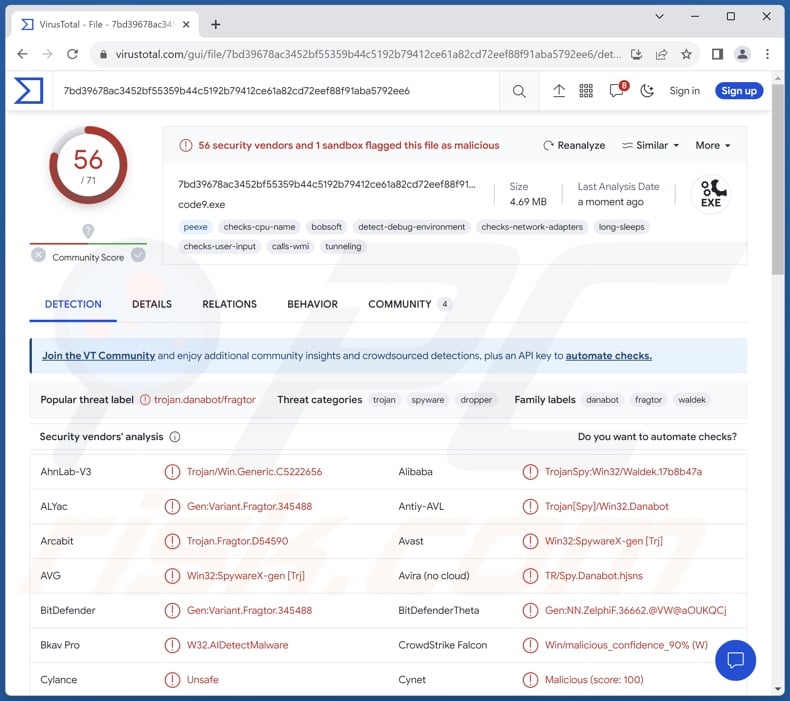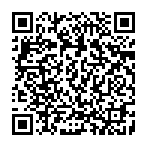How to eliminate HijackLoader malware from the operating system
![]() Written by Tomas Meskauskas on (updated)
Written by Tomas Meskauskas on (updated)
What kind of malware is HijackLoader?
HijackLoader is a loader-type malware. It is designed to cause chain infections, i.e., download/install additional malware onto infected machines. HijackLoader is rather basic in and of itself – however, it relies on multiple modules to greatly expand its arsenal of features.
This loader has been around since at least the summer of 2023. It has been observed infecting systems with DanaBot, RedLine, and SystemBC.

HijackLoader malware overview
As mentioned in the introduction, HijackLoader operates by causing chain infections. While its base capabilities are limited, the malware relies on close to twenty downloaded modules to gain additional functionality.
HijackLoader utilizes several anti-detection techniques. The malware implements a module containing details of security tools that it attempts to evade and block (full list).
The program's behavior may differ depending on the security software present on the compromised device. For example, it makes no changes in protocol if it detects Microsoft Defender, the presence of Emsisoft or Webroot force HijackLoader to skip its connectivity tests, while in the case of Avast or AVG – the malware delays its execution for forty seconds.
Furthermore, HijackLoader uses modules to gain injector capabilities, i.e., injection of malicious code into programs and processes.
Multiple modules are used to prepare the system for the final payload. While HijackLoader has been utilized to infect devices with DanaBot, RedLine, and SystemBC – that does not mean that it could not be used to load other malware onto systems (e.g., trojans, ransomware, cryptocurrency miners, etc.).
It must be mentioned that malware developers commonly improve upon their software and methodologies; hence, potential future releases of HijackLoader could boast additional/different functionalities or features.
To summarize, the presence of software like HijackLoader on devices can result in multiple system infections, decreased system performance or failure, data loss, severe privacy issues, financial losses, and identity theft.
| Name | HijackLoader virus |
| Threat Type | Trojan, loader, injector. |
| Detection Names | Avast (Win32:SpywareX-gen [Trj]), Combo Cleaner (Gen:Variant.Fragtor.345488), ESET-NOD32 (A Variant Of Win32/Spy.Danabot.V), Kaspersky (HEUR:Trojan.Win32.Waldek.gen), Microsoft (Trojan:Win32/Casdet!rfn), Full List Of Detections (VirusTotal) |
| Payload | DanaBot, RedLine, SystemBC, etc. |
| Symptoms | Trojans are designed to stealthily infiltrate the victim's computer and remain silent, and thus no particular symptoms are clearly visible on an infected machine. |
| Distribution methods | Infected email attachments, malicious online advertisements, social engineering, software 'cracks'. |
| Damage | Stolen passwords and banking information, identity theft, the victim's computer added to a botnet. |
| Malware Removal (Windows) | To eliminate possible malware infections, scan your computer with legitimate antivirus software. Our security researchers recommend using Combo Cleaner. |
Loader-type malware examples
We have analyzed thousands of malware samples; WikiLoader, CustomerLoader, ModernLoader, and IceXLoader are just some examples of loaders. Loader-type software can be designed to infect systems with a certain program or a specific type of malware, while others can infiltrate all kinds of malicious programs.
Furthermore, malware can have a broad range of capabilities in varied combinations. However, regardless of how malicious software operates – its presence on a system endangers device integrity and user safety. Therefore, all threats must be eliminated immediately upon detection.
How did HijackLoader infiltrate my computer?
Exactly how HijackLoader is distributed is unknown. Generally, malware is proliferated using phishing and social engineering techniques.
Malicious programs are usually disguised as or bundled with ordinary software/media. Infectious files can be archives (ZIP, RAR, etc.), executables (.exe, .run, etc.), documents (Microsoft Office, Microsoft OneNote, PDF, etc.), JavaScript, and so forth.
The most widely utilized methods include: drive-by (stealthy/deceptive) downloads, online scams, malvertising, malicious attachments and links in spam mail (e.g., emails, PMs/DMs, SMSes, etc.), untrustworthy download sources (e.g., freeware and free file-hosting websites, Peer-to-Peer sharing networks, etc.), illegal software activation tools ("cracks"), and fake updates.
What is more, some malicious programs can self-spread via local networks and removable storage devices (e.g., external hard drives, USB flash drives, etc.).
How to avoid installation of malware?
We highly recommend downloading only from official and verified channels. Additionally, all programs must be activated and updated using legitimate functions/tools provided by genuine developers, as illegal activation ("cracking") tools and third-party updates may contain malware.
Another recommendation is to be careful while browsing since fake and malicious online content usually appears legitimate and harmless. We advise exercising caution with incoming emails and other messages. Attachments or links found in suspect mail must not be opened, as they can be virulent.
We must emphasize the importance of having a dependable anti-virus installed and kept up-to-date. Security programs must be used to run regular system scans and to remove detected threats. If you believe that your computer is already infected, we recommend running a scan with Combo Cleaner Antivirus for Windows to automatically eliminate infiltrated malware.
HijackLoader malware's block list: 360 Safeguard, 360 Total Security, Avast, AVG, Avira, BitDefender, ByteFence, Comodo Internet Security, Emsisoft, ESET, Internet Security Essentials, Kaspersky, Malwarebytes, McAfee, Microsoft Defender, Norton 360, Symantec Event Manager, Trend Micro Internet Security, and Webroot.
Instant automatic malware removal:
Manual threat removal might be a lengthy and complicated process that requires advanced IT skills. Combo Cleaner is a professional automatic malware removal tool that is recommended to get rid of malware. Download it by clicking the button below:
▼ DOWNLOAD Combo Cleaner
By downloading any software listed on this website you agree to our Privacy Policy and Terms of Use. To use full-featured product, you have to purchase a license for Combo Cleaner. 7 days free trial available. Combo Cleaner is owned and operated by Rcs Lt, the parent company of PCRisk.com read more.
Quick menu:
- What is HijackLoader?
- STEP 1. Manual removal of HijackLoader malware.
- STEP 2. Check if your computer is clean.
How to remove malware manually?
Manual malware removal is a complicated task - usually it is best to allow antivirus or anti-malware programs to do this automatically. To remove this malware we recommend using Combo Cleaner Antivirus for Windows.
If you wish to remove malware manually, the first step is to identify the name of the malware that you are trying to remove. Here is an example of a suspicious program running on a user's computer:

If you checked the list of programs running on your computer, for example, using task manager, and identified a program that looks suspicious, you should continue with these steps:
 Download a program called Autoruns. This program shows auto-start applications, Registry, and file system locations:
Download a program called Autoruns. This program shows auto-start applications, Registry, and file system locations:

 Restart your computer into Safe Mode:
Restart your computer into Safe Mode:
Windows XP and Windows 7 users: Start your computer in Safe Mode. Click Start, click Shut Down, click Restart, click OK. During your computer start process, press the F8 key on your keyboard multiple times until you see the Windows Advanced Option menu, and then select Safe Mode with Networking from the list.

Video showing how to start Windows 7 in "Safe Mode with Networking":
Windows 8 users: Start Windows 8 is Safe Mode with Networking - Go to Windows 8 Start Screen, type Advanced, in the search results select Settings. Click Advanced startup options, in the opened "General PC Settings" window, select Advanced startup.
Click the "Restart now" button. Your computer will now restart into the "Advanced Startup options menu". Click the "Troubleshoot" button, and then click the "Advanced options" button. In the advanced option screen, click "Startup settings".
Click the "Restart" button. Your PC will restart into the Startup Settings screen. Press F5 to boot in Safe Mode with Networking.

Video showing how to start Windows 8 in "Safe Mode with Networking":
Windows 10 users: Click the Windows logo and select the Power icon. In the opened menu click "Restart" while holding "Shift" button on your keyboard. In the "choose an option" window click on the "Troubleshoot", next select "Advanced options".
In the advanced options menu select "Startup Settings" and click on the "Restart" button. In the following window you should click the "F5" button on your keyboard. This will restart your operating system in safe mode with networking.

Video showing how to start Windows 10 in "Safe Mode with Networking":
 Extract the downloaded archive and run the Autoruns.exe file.
Extract the downloaded archive and run the Autoruns.exe file.

 In the Autoruns application, click "Options" at the top and uncheck "Hide Empty Locations" and "Hide Windows Entries" options. After this procedure, click the "Refresh" icon.
In the Autoruns application, click "Options" at the top and uncheck "Hide Empty Locations" and "Hide Windows Entries" options. After this procedure, click the "Refresh" icon.

 Check the list provided by the Autoruns application and locate the malware file that you want to eliminate.
Check the list provided by the Autoruns application and locate the malware file that you want to eliminate.
You should write down its full path and name. Note that some malware hides process names under legitimate Windows process names. At this stage, it is very important to avoid removing system files. After you locate the suspicious program you wish to remove, right click your mouse over its name and choose "Delete".

After removing the malware through the Autoruns application (this ensures that the malware will not run automatically on the next system startup), you should search for the malware name on your computer. Be sure to enable hidden files and folders before proceeding. If you find the filename of the malware, be sure to remove it.

Reboot your computer in normal mode. Following these steps should remove any malware from your computer. Note that manual threat removal requires advanced computer skills. If you do not have these skills, leave malware removal to antivirus and anti-malware programs.
These steps might not work with advanced malware infections. As always it is best to prevent infection than try to remove malware later. To keep your computer safe, install the latest operating system updates and use antivirus software. To be sure your computer is free of malware infections, we recommend scanning it with Combo Cleaner Antivirus for Windows.
Frequently Asked Questions (FAQ)
My computer is infected with HijackLoader malware, should I format my storage device to get rid of it?
Most malicious programs can be removed without restoring to formatting.
What are the biggest issues that HijackLoader malware can cause?
The dangers associated with an infection depend on the malware's capabilities and the cyber criminals' modus operandi. HijackLoader is designed to cause chain infections, and it has injector capabilities. It has been noted infecting devices with DanaBot, RedLine, and SystemBC – but other programs are not unlikely. In general, malware of this kind can cause multiple system infections, data loss, severe privacy issues, financial losses, and identity theft.
What is the purpose of HijackLoader malware?
Most malware infections are motivated by financial gain. However, cyber criminals can also use malicious software to amuse themselves, carry out personal grudges, disrupt processes (e.g., websites, services, companies, etc.), and even launch politically/geopolitically motivated attacks.
How did HijackLoader malware infiltrate my computer?
Malware is mainly spread via drive-by downloads, spam mail, online scams, malvertising, untrustworthy download sources (e.g., freeware and third-party sites, P2P sharing networks, etc.), illegal program activation tools ("cracks"), and fake updates. What is more, some malicious programs can self-proliferate through local networks and removable storage devices.
Will Combo Cleaner protect me from malware?
Yes, Combo Cleaner is capable of detecting and eliminating nearly all known malware infections. It must be stressed that running a complete system scan is paramount – since sophisticated malicious programs tend to hide deep within systems.


▼ Show Discussion